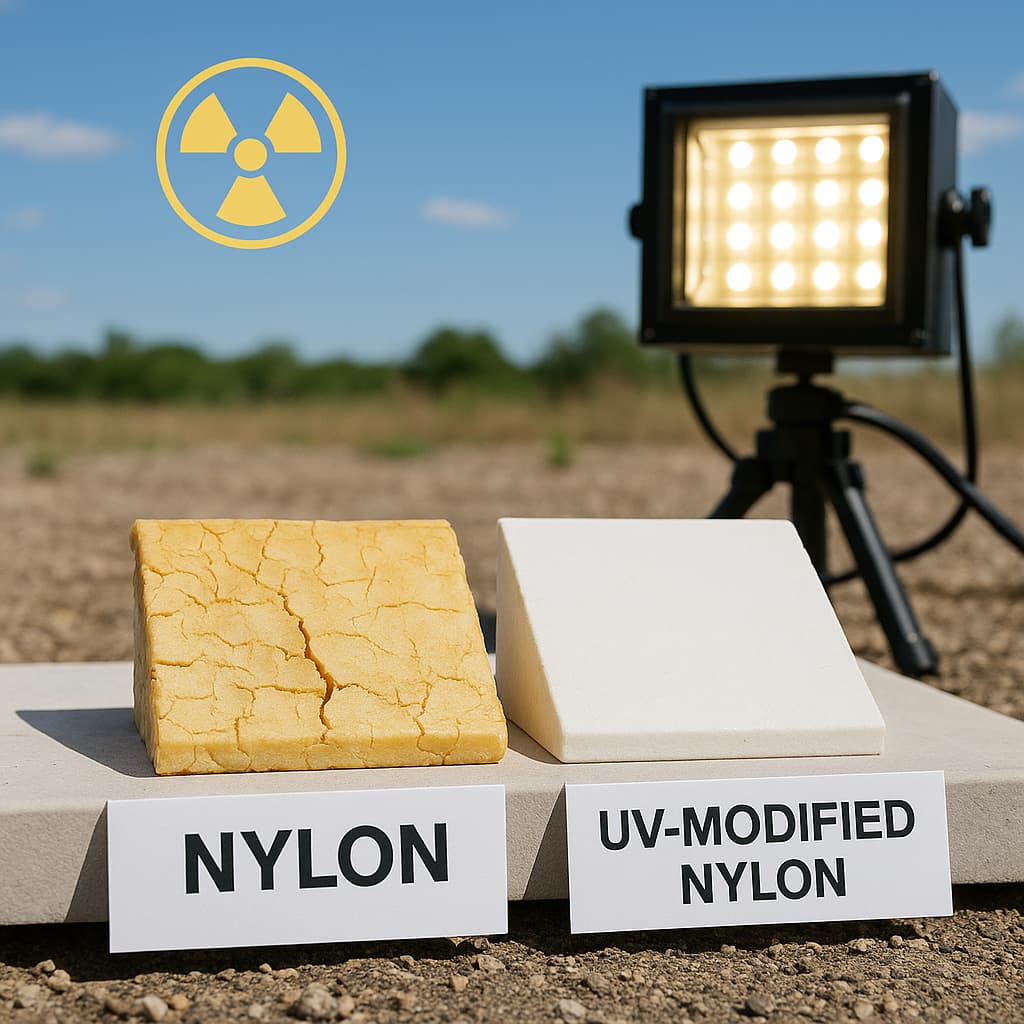Nylon (polyamide) is a high-performance engineering plastic widely used in automotive components, electronics, textiles, sports equipment, and outdoor gear due to its excellent mechanical strength, wear resistance, and chemical stability. However, prolonged exposure to ultraviolet (UV) radiation can lead to photo-oxidative degradation, causing chain scission, yellowing, surface chalking, and deterioration of mechanical properties. This significantly impacts both the lifespan and appearance of nylon products, particularly in outdoor applications such as automotive exteriors, construction materials, and sporting goods. Therefore, enhancing the UV resistance of nylon through material modification has become a critical research focus in polymer science and engineering.
Ultraviolet absorbers (UVAs) are one of the most effective additives for improving nylon’s UV stability. These compounds selectively absorb UV light (particularly in the 290-400 nm range, including UV-A and UV-B) and convert it into harmless thermal energy, thereby minimizing damage to the polymer matrix. Common UVAs include benzotriazoles (e.g., BASF’s Tinuvin 326, Tinuvin 328) and benzophenones (e.g., Clariant’s Chimassorb 81). To ensure optimal performance, UVAs must be uniformly dispersed in the nylon matrix, typically via melt blending or masterbatch incorporation. Studies show that adding 0.5%-2% UVA can significantly delay photoaging, extending the service life of nylon in outdoor environments.
Hindered amine light stabilizers (HALS) are another essential class of additives for UV protection. Unlike UVAs, HALS do not absorb UV radiation but instead scavenge free radicals generated during photo-oxidation, thereby inhibiting degradation. Notable commercial HALS products include Tinuvin 770 (BASF) and Cyasorb UV-3853 (Solvay). Due to their long-term stability, HALS are particularly suitable for high-durability applications. Importantly, UVAs and HALS exhibit a synergistic effect—combining them (e.g., Tinuvin 326 + Tinuvin 770) provides comprehensive UV shielding by both absorbing radiation and suppressing radical reactions, significantly enhancing nylon’s weatherability.
Incorporating inorganic nanoparticles is another effective strategy to improve UV resistance. Metal oxides such as titanium dioxide (TiO₂) and zinc oxide (ZnO) are widely used due to their ability to scatter and reflect UV light. Rutile TiO₂, with its high refractive index, offers excellent UV blocking while improving rigidity and thermal stability. Nano-ZnO not only shields UV but also provides antibacterial properties, making it suitable for medical and packaging applications. To ensure uniform dispersion, surface modification (e.g., silane coupling agents) is often applied to prevent agglomeration and enhance interfacial adhesion. Additionally, advanced nanomaterials like carbon nanotubes (CNTs) and graphene are being explored for UV protection, as they can absorb radiation while improving electrical conductivity and mechanical strength.
Polymer blending is another viable approach to enhance UV stability. By blending nylon with inherently UV-resistant polymers (e.g., polycarbonate (PC) or polyphenylene oxide (PPO)), its susceptibility to degradation can be reduced. However, due to poor compatibility, compatibilizers (e.g., maleic anhydride-grafted polyethylene) are often required to improve interfacial adhesion. Chemical modifications, such as grafting or crosslinking, can also improve UV resistance. For instance, introducing acrylate or styrene monomers onto nylon chains can reduce photo-oxidation, enhancing long-term stability.
In practical applications, the choice of UV stabilization strategy depends on cost, processing requirements, and end-use conditions. Automotive exterior parts (e.g., door handles, mirror housings) require high-load UVA/HALS combinations with glass fiber reinforcement for dimensional stability. In contrast, electronic components (e.g., connectors, housings) may use lower stabilizer doses due to milder environments. For optically clear applications (e.g., films), low-molecular-weight benzotriazoles are preferred to maintain transparency.
Future trends include developing eco-friendly UV stabilizers (e.g., lignin derivatives, polyphenols) and smart materials (e.g., photochromic additives) for advanced applications. Through continuous innovation, nylon’s UV resistance will further improve, enabling its use in even harsher environments.
